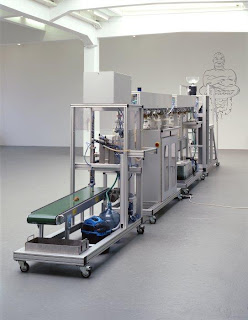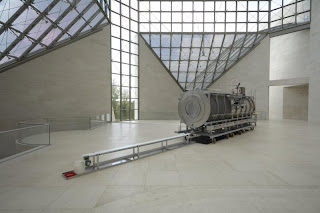

















Win Delvoye is a Belgian artist whose elaborate artworks exhibit a wicked sense of humour. Delvoye’s Cloaca artworks are relevant to the field of Art & Nature and Technology, in that they are essentially machines that exhibit human characteristics (Heartney, 2008). Cloaca is a valid manifestation of Heartney’s bio art with the artworks exhibiting a collision of technology, which is demonstrated by the machines, and nature, which is illustrated with the human characteristic of digestion. Cloaca is a gigantic machine that performs one human, bodily function, that when confronted, the viewer can shockingly, identify with. Cloaca challenges the modern condition of uncertainty, concerning “where human life begins and ends” (Cameron, 2008).
Visually, Cloaca is an assembly line of machines and computers that resemble a scientist’s laboratory. At one end is an opening that is fed prepared, gourmet meals periodically, which then progress though a simulated process of human digestion. Eventually, at the other end of Cloaca, the machine dispenses of several samples that have been tested to be almost human. The excreted matter is then individually packaged and sold (Criqui, 2001).
Delvoye’s Cloaca expresses a provocative statement concerning “our ultra-consumerist society” (Amy, 2008). Humans utilise technology to make objects that are desired, only to dispose of them shortly after.

Wim Delvoye, Cloaca New & Improved, 2001. Mixed Media, 1000 x 75 x 200cm. Migros Museum (25.08 - 14.10.2001).

Wim Delvoye, Cloaca Turbo, 2003. Mixed Media, 826 x 128 x 200 cm. Casino Luxembourg (30.09.2007 - 06.01.2008).

Wim Delvoye, Super Cloaca, 2007. Mixed Media, 1470 x 211 x 307 cm. Mudam, Guest House (13.10.2007 – 26.11.2007).
Bibliography
Books and articles:
Amy, Michael. “Wim Delvoye at the Museum van Hedendaagse Kunst.” Art in America 89.5 (2001): 185.
Criqui, Jean-Pierre. “Eater’s Digest.” Artforum International 40.1 (2001): 182.
Delvoye, Wim. Cloaca / Wim Delvoye. New York: New Museum of Contemporary Art in association with Rectapublishers, 2001.
Heartney, Eleanor. Art and Today. London: Phaidon Press Limited, 2008.
Images:
All images reproduced from http://www.wimdelvoye.be/ (accessed April 20, 2009).
Websites:
http://www.wimdelvoye.be/ (accessed April 20, 2009).
http://www.cloaca.be/articles.htm (accessed April 20, 2009).







Performance Space is looking for gallery invigilators for the exhibition There Goes the Neighbourhood which opens Friday 22 May 6pm in Bay 19 @ CarriageWorks and runs until Saturday 27 June. The gallery is open Tues – Sat 12 – 6pm (unless there is another P Space event on and then the gallery will be open until 8pm) and the cost is FREE. There Goes the Neighbourhood curated by Zanny Begg and Keg de Souza is an exhibition, publishing project and forum for dialogue investigating the politics of urban space. Drawing on the immediate experiences of Redfern, local and international artists explore the complex life of cities and how gentrification is altering the relationship between democracy and demography around the world.
Volunteer responsibilities will include; inviting people into the space, managing the flow of traffic, relaying information and helping patrons interpret the works, selling catalogues, opening/closing the exhibition, starting up/shutting down the exhibits, and supervising and maintenance of the works.
Further information: http://www.performancespace.com.au/









I didn’t start to understand this chapter fully until about the third page because there were too many differing expressions about the ambiguous topic of time. It really got me thinking about the exhibition Crying Men by artist Sam Taylor-Wood, in particular, the installation of David Beckham sleeping but I didn’t know why. However, when I reached the part on Bruce Nauman, the chapter became clear. Sam Taylor-Wood, like Nauman has redirected our attention to the minute events that occur when seemingly nothing is happening.[1] Taylor-Wood has captured reel time and real time together, the unedited and the unmediated by surveilling.[2] Famous sportsman, David Beckham is shown, in her installation, at his most vulnerable. She has cleverly made the uneventful, tiny event become magnified.[3] There is ofcourse, nothing new about this approach- see Warhols’ Sleep.[4] The entire exhibition is focused on the subject of time and I think we are all fascinated by it. Time is something we cannot control but would like to very much and perhaps, this is our way of pretending we can.



 Tide, 2008
Tide, 2008
